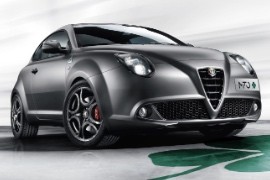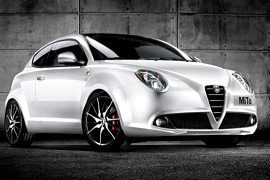ALFA ROMEO MiTo Quadrifoglio Verde Models/Series Timeline, Specifications & Photos
First production year: 2009
Engines: Gasoline
Body style: Hatchback
After the financial crisis, Alfa Romeo finally facelifted its smallest-sized vehicle in the lineup, the MiTo, and along with it, the Italian automaker refreshed the most powerful version of it, the Quadrifoglio Verde.
During the world financial crisis, many automakers found themselves in a tight spot. Fiat Group, on the other hand, managed to secure its finances way better than other automakers. But it did that with some radical decisions, and one of them was to keep the MiTo unchanged until 2013 when it finally refreshed it. Some upgrades were difficult to spot, while others were obvious. There were some exterior and interior changes across the range, and some of them were implemented into the Quadrifoglio Verde (four-cloves) version. This unusual name traced its roots back to the 1923 Targa Florio competition, which Alfa Romeo won. The carmaker’s team employed four race drivers for that event: Giulio Masetti, Ugo Sivocci, Antonio Ascari, and Enzo Ferrari. From then on, the sportiest version of the automaker’s vehicles had that unique badge, including the MiTo.
There were no significant changes at the car’s front, except for the four dark burnished slats adorning the Alfa Romeo shield. At the same time, the lower-spec versions of the MiTo had chromed elements. In addition, the automaker restyled and darkened the door mirror caps, handles, and headlights surroundings. Furthermore, the Quadrifoglio Verde badge adorned the front fenders, under the turn signal lamps.
From its profile, the dark design of the 17-inch light-alloy wheels contrasted with the red calipers of the Brembo braking system. A matte Magnesio Grey color was also offered for this version of the MiTo. Like its non-facelifted version, the 2013 MiTo QV featured large wheel arches on both axles and aerodynamically profiled side sills. Finally, at the back, the automaker added burnished surroundings for the taillights, while underneath the bumper it placed a twin exhaust.
Inside, customers were greeted by either standard, leather-wrapped high-bolstered bucket seats, but customers had the option to go for a set of Sabelt sports seats covered in Alcantara and with carbon fiber backrest. In addition, the automaker stitched the QV logo on the seats. In front of the driver, Alfa Romeo placed a four-dial instrument panel with a red TFT display in the middle that showed essential data for the one behind the wheel. Customers could opt for a new infotainment system developed together with Continental. It was available with the TomTom navigation system and included an advanced Bluetooth connection that allowed SMS text message readings via text-to-speech function. Furthermore, the 5-inch touchscreen allowed customers to select their desired music from their iPods connected to the system via a USB port. In the back, the split-folding (60/40) seatback could expand the trunk space.
There were no significant upgrades in the MiTo QV range compared to its predecessor. The turbocharged 1.4-liter gasoline unit produced 170 PS (168 hp). But Alfa Romeo still had an ace up its sleeve: the six-speed dual-clutch gearbox. Thanks to its low reaction time, this unit could ensure better acceleration times thanks to its quicker gear changes.
ALFA ROMEO MiTo Quadrifoglio Verde 1.4L Turbo MultiAir 6MT (170 HP)
Alfa Romeo injected some of its DNA into the mundane platform of a Fiat Grande Punto, and the result was the pocket-rocket 2009 MiTo Quadrifoglio Verde (four-cloves).
While this unusual nameplate might not mean anything to anyone, it means a lot for Alfa Romeo fans, or the “alfisti,” as they are called. The four-clove badge was initially painted on the four race cars driven by Giulio Masetti, Ugo Sivocci, Antonio Ascari, and Enzo Ferrari. Yes, it is the same Ferrari who later created the magnificent supercar manufacturing company. This badge was used on many other sporty vehicles built by Alfa Romeo, and it represented the most potent version of a car model in the automaker’s lineup. The MiTo Quadrifoglio Verde was no exception since the Italian engineers managed to create a hot hatch for the masses. For that, they took a small-sized engine, turbocharged it, and dropped it inside the engine bay of a MiTo. But that was just part of the transformation.
The car’s exterior was radically enhanced. At the front, the tri-lobo (three lobes) fascia featured the center-mounted Alfa Shield flanked at the bottom by a pair of horizontal air intakes. There, the automaker introduced the round fog lamps, while above, it placed the Xenon headlamps inside the triangular-shaped headlights.
From its profile, the MiTo QV screamed for attention with its enlarged front and rear fenders. In addition, Alfa Romeo installed aerodynamically profiled side sills. A set of 17-inch wheels with a unique design for this version was also included in the process. At the back, to complete the racy look of the supermini hatchback, the automaker installed a roof spoiler, while on the lower side, underneath the bumper, it placed a twin exhaust with chromed tips. Like its non-QV sibling, this much more potent version of the MiTo was available exclusively as a three-door hatchback.
But Alfa Romeo didn’t want to leave the cabin untouched by race-inspired details. As a result, the dashboard and the door cards were adorned with carbon-fiber trims. However, the most eye-catching element was the sports seats with integrated headrests. These featured high-bolstered areas to keep their occupants in place during high-speed cornering maneuvers. Alfa Romeo also offered an option for a mix of Alcantara/leather upholstery. Fronting the driver was the same binocular-styled instrument cluster filled with the large dials of the speedometer and tachometer. Between them, the automaker installed a TFT display that showed data from the car’s onboard computer. On the center console, drivers found the gear stick and the button for the DNA system that controlled suspension, brakes, and engine management. In the back, besides the upholstery, nothing got changed.
Under the hood, Alfa Romeo installed a 1.4-liter turbocharged engine, which was previously used for the 150 PS (144 HP) version. From this four-pot powerplant, Alfa Romeo engineers squeezed 170 PS (168 hp), which were sent to the front wheels via a six-speed manual gearbox. The adaptive suspension was made by Magneti Marelli, which turned the small-sized mundane vehicle into a legit canyon carver.
ALFA ROMEO MiTo Quadrifoglio Verde 1.4 MultiAir 6AT (170 HP)

